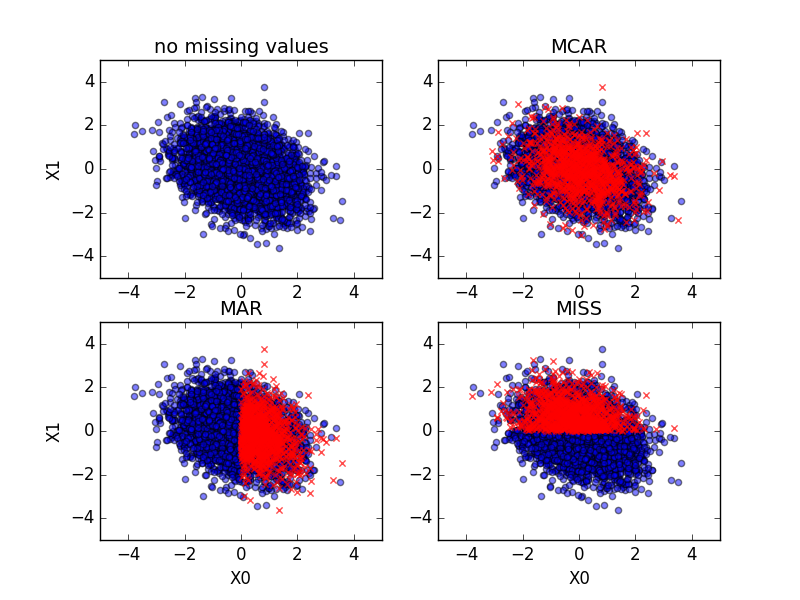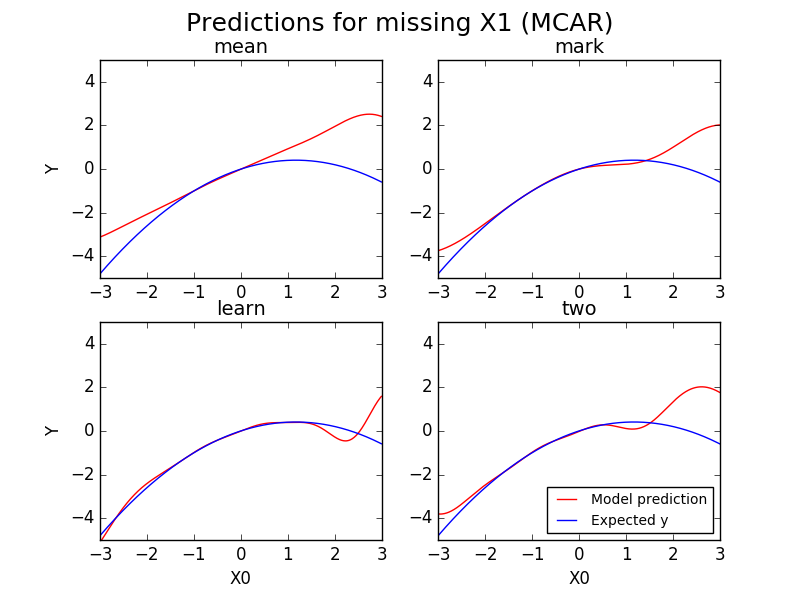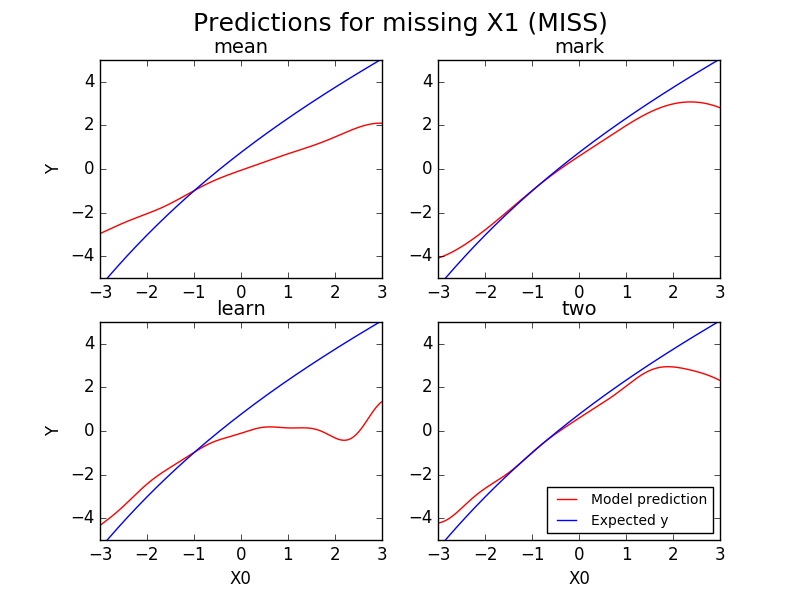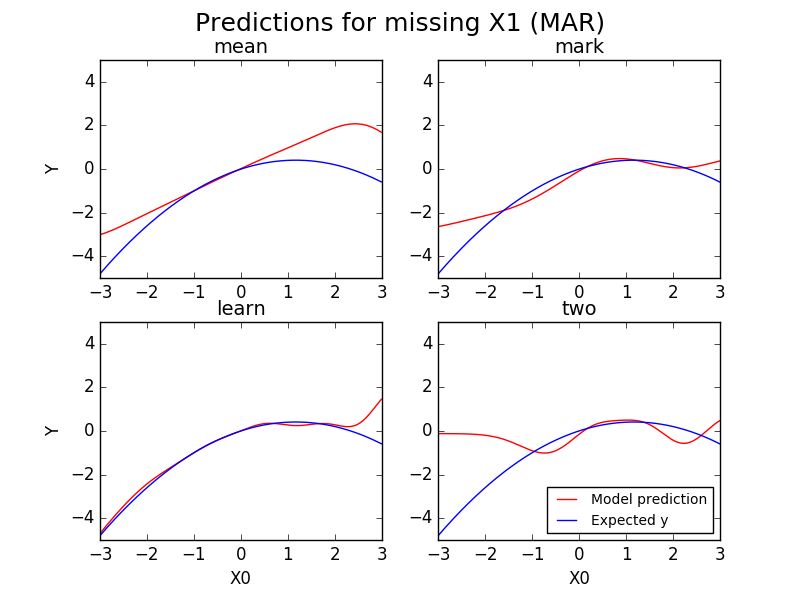Missing Data
\(\newcommand{\P}{\mathbf P}\) \(\newcommand{\E}{\mathbf E}\)
Introduction
Several strategies for learning in the presence of missing data are in common use. In this post I'll apply some of these strategies to an artifically generated dataset and show that one of the common strategies, mean imputing, is a poor approach. I'm going to use artificial data to more clearly illustrate the different ways in which data can be missing.
The data
Suppose we have random variables $(X_0,X_1)$ sampled from a multivariate normal distribution with mean $(0,0)$ and covariance
\[\Sigma= \begin{pmatrix} 1 & -0.3\\ -0.3 & 1 \end{pmatrix}. \]
Now let $Y = X_0 + X_1 + X_0 X_1 + \epsilon$, where $\epsilon$ is a normal random variable with mean $0$ and $\sigma^2=0.0025$ (the noise in the data).
We will sample $5000$ data points $(X_0,X_1)$, and then discard some of the $X_1$ values. We will train regressors to predict $Y$. The data points which will have $X_1$ discarded are selected based on one of these three approaches:
In the missing completely at random (MCAR) approach, 20% of the data points are selected uniformly from among all $5000$ points.
In the missing at random (MAR) approach, 40% of the data points are considered, but of those, only those with $X_0 \ge 0$ are selected.
In the just plain missing (MISS) approach, 40% of the data points are considered, but of those, only those with $X_1 \ge 0$ are selected.1
In the Bayesian statistics literature, it seems that MCAR is considered the ideal, but rarely occurs in practice. MAR is considered the next best thing, because whether your data is missing does not depend on the missing data itself. However, in some situations, MISS may in fact be preferable, because the fact that data is missing gives us some information that partly makes up for not being able to see $X_1$.
Here are scatter plots of the data. The blue points have $X_1$ available, while the red crosses do not.

Tackling the problem
Here are a few approaches to handling a dataset with some points missing $X_1$ before passing the data to a regressor:
Mean imputing: compute the mean $\mu$ of $X_1$ among those points where it is not missing, and let $X_1=\mu$ for those points where it is missing.
Learn: Train a regressor on the data where $X_1$ is available, using $X_0$ as the single feature and $X_1$ as the target. Then use the regressor to predict $X_1$ where it is missing.
Mark: Adjoin to each data point an additional indicator variable $X_2$ such that $X_2=0$ if $X_1$ is present and $X_2=1$ if $X_1$ is missing. For the algorithms in sklearn, it's also necessary to give $X_1$ some value where it is missing, so we also do mean imputing.
Two: Train one regressor on the samples where all values are available, and a second regressor on the samples where $X_1$ is missing. When making predictions, use the first or second regressor according to whether $X_1$ is available or missing.
I (somewhat arbitrarily) used as a base regressor sklearn's
SVR
which performs support vector regression. I trained SVR with each of the
above four approaches on data sets with each of the three types of missing
data. I then generated $500$ test data points which were missing data
according to the same three approaches. Each model was tested and its mean
square error (MSE) was computed.
The results
The procedure described above resulted in the MSE values given in the following table.
| | Mean | Learn | Mark | Two | |-------| | | | | | MCAR | 0.22 | 0.23 | 0.22 | 0.22 | | MAR | 0.65 | 0.59 | 0.59 | 0.60 | | MISS | 0.31 | 0.50 | 0.11 | 0.11 |
Two observations stand out in this table. Firstly, the MISS scenario allows the most accurate predictions by far. Thus, while MCAR and MAR may simplify the statistical analysis, they are not necessarily the most desirable scenarios in practice.
The second is that Mark and Two are the most consistently high performing strategies: they tie with Mean in the MCAR scenario, slightly edge out Mean in the MAR scenario, and trounce both Mean and Learn in the MISS scenario.
It's not hard to understand why Mark and Two perform so much better in the MISS scenario: Mean imputing is simply lying to your model. You are making up fake data and hoping your model isn't misled too badly. In the MCAR and MAR scenarios, this turns out to not be a complete disaster because of two factors:
The fact that $Y$ is a linear function of $X_1$ (up to the noise term) means that imputing the mean of $X_1$ given that it is missing amounts to the best possible estimate anyway.
The mean of $X_1$ is the same as the mean of $X_1$ given that it is missing. That is, $\E[X_1] = \E[X_1 | X_1 \textrm{ is missing} ] = 0$.
But in the MISS scenario, $\E[X_1 | X_1 \textrm{ is missing} ] > 0$, and so factor 2 does not hold. We have imputed a value that is almost assured to lead to incorrect predictions.
Learn also can't handle MISS because $X_1$ and $X_0$ are not strongly correlated enough to allow the regressor to predict $X_1$ based on $X_0$.
Mark and Two perform similarly because, for a regressor that can handle a high level of nonlinearity, the indicator variable $X_2$ allows Mark to treat the data points with $X_1$ missing differently from the data points with $X_1$ available.
We can also get a picture of the performance of the various strategies by plotting the prediction each model makes for a given $X_0$. In these plots, the blue curves are the expected $Y$ value, that is, $\E[Y | X_0 = x_0 \textrm{ and } X_1 \textrm{ is missing}]$. This is the prediction that would minimize the MSE. The red curves are the predictions of each model..
First we look at predictions in the MCAR scenario.

The all look fairly similar, as was also reflected in the table of MSE values.
Now we look at predictions in the MISS scenario. In this scenario, the expected value of $Y$ is $\E[Y | X_0 = x_0 \textrm{ and } X_1 \ge 0]$.

Now we see a clear distinction between, on the one hand, Mean and Learn and, on the other hand, Mark and Two. Mean and Learn have been misled by the missing data, and dramatically underestimate $Y$ when $X_0>-1$.
Finally, just for fun we look at the predictions in the MAR scenario also. This is somewhat meaningless as, for values of $X_0 < 0$, there are never missing $X_1$ values. In these plots I have used the same curve for the expected $Y$ value as from the MCAR scenario even though, when $X_0<0$ this is really meaningless. We should expect our models to predict similarly to MCAR when $X_0 \ge 0$, but let's see how they do when $X_0<0$.

We find that, indeed, all the red curves here are pretty similar to the red curves in MCAR in the region $X_0 \ge 0$. In $X_0<0$ Mean and Learn still look pretty close to what they were in MCAR. It's a different story for Mark and Two; they are way off base for $X_0<0$. Two in particular doesn't know what to do, which isn't surprising, as we are taking a regressor that was trained on data where $X_0 \ge 0$ always, and having it make predictions for $X_0 < 0$.
Of course the nice thing is that this doesn't matter, because in the MAR scenario we never have $X_0<0$ when $X_1$ is missing.
Another regressor
In this section I'll repeat a small portion of the above analysis with
a DecisionTreeRegressor
with max_depth=18. Training a regressor with each strategy in each scenario
results in the following table of MSE values.
| | Mean | Learn | Mark | Two | |-------| | | | | | MCAR | 0.32 | 0.87 | 0.31 | 0.34 | | MAR | 1.15 | 2.39 | 1.15 | 1.45 | | MISS | 0.18 | 0.84 | 0.18 | 0.19 |
Again, two things of note stand out. Firstly, Learn clearly works very poorly
with the DecisionTreeRegressor. Secondly, Mean now works just as well as Mark
and Two in the MISS scenario. What is going on? Is it possible that mean
imputing can be salvaged after all?
No, mean imputing is still a bad idea. But the DecisionTreeRegressor is
capable of handling a severe discontinuity in predicting $Y$ as a function of
$X_0$ and $X_1$: it can recognize that the points with $X_1$ exactly at
the mean behave very differently from the points with $X_1$ merely close to
the mean. Thus mean imputing works just fine. But this isn't because mean
imputing is a good idea; this regressor would be able to do the same with any
arbitrary imputed value.
Another method
Another much more complicated method to handle missing values is multiple imputation. For now I don't have much to say on this method, except that I think imputing in general is the wrong approach.
Conclusion
Mean imputing is usually a bad idea. The marking and two-model approach are both pretty simple to implement and tend to give good results. I consider marking to be a rough approximation of the two-model approach. Unfortunately marking is not currently a built-in option in sklearn, but there is an open issue to add it.
Looking at the tables of MSE values I've given, I still have one question whose answer I'm not yet sure of. Why do both regressors perform much more poorly for MAR data than for MCAR? I'll update this post if I find a simple reason.
- Note that missing completely at random and missing at random are extant technical terms. They don't in general refer to the specifics of how much data is missing that I've given here. Instead MCAR refers to the fact that whether the data is missing doesn't depend on $X_0$ or $X_1$, while MAR refers to the fact that whether the data is missing doesn't depend on $X_1$. On the other hand, just plain missing is a term I just made up. [return]